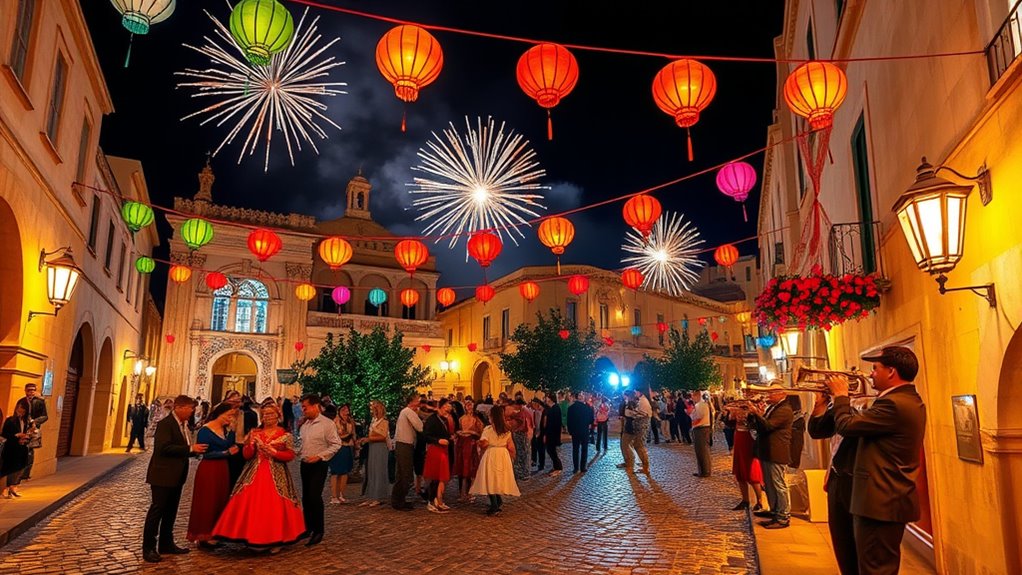Discover Malta’s top attractions, from its ancient UNESCO World Heritage Sites like the Megalithic Temples and the Hypogeum to its vibrant historic cities such as Valletta and Mdina. Enjoy stunning beaches like Golden Bay and the Blue Lagoon, explore fascinating museums, and immerse yourself in lively festivals like Fireworks and Notte Bianca. There’s so much more to uncover about Malta’s rich history, natural beauty, and culture—keep exploring to see everything this island has to offer.
Key Takeaways
- Megalithic Temples of Malta, such as Ġgantija and Ħaġar Qim, are some of the world’s oldest free-standing structures.
- The historic cities of Valletta and Mdina showcase Renaissance and medieval architecture, fortified walls, and cultural landmarks.
- Blue Lagoon in Comino and beaches like Golden Bay offer stunning natural scenery and water-based activities.
- Museums like St. John’s Co-Cathedral and the National Museum of Archaeology highlight Malta’s rich history and art.
- Festivals such as the Malta International Fireworks Festival and Notte Bianca celebrate local culture and traditions.
UNESCO World Heritage Sites

Have you ever wondered what makes Malta’s archaeological and cultural heritage truly exceptional? It’s the remarkable UNESCO World Heritage Sites that showcase Malta’s rich history. The Megalithic Temples of Malta, including Ġgantija and Ħaġar Qim, are among the world’s oldest free-standing structures, dating back to 3600 BC. The Ħal Saflieni Hypogeum, an underground sanctuary and necropolis from around 3300 BC, reveals prehistoric spiritual practices. The City of Valletta, founded in 1566, features over 320 monuments, with stunning Baroque architecture and fortified walls. These sites are recognized globally for their outstanding universal value and deepen your understanding of Malta’s ancient civilizations, religious history, and strategic importance. All three sites are protected and celebrated, making Malta a living museum of human achievement.
Historic Cities and Fortifications

Malta’s historic cities and fortifications offer a vivid glimpse into the island’s strategic importance and rich past. As you explore Valletta, you’ll see a well-planned Renaissance city with landmarks like St. John’s Co-Cathedral and the Grandmaster’s Palace, showcasing Baroque grandeur. Mdina, the “Silent City,” invites you to wander its narrow, medieval streets and enjoy commanding views over Malta. On Gozo, the Cittadella stands as a fortified hilltop town with historic buildings and panoramic vistas. Don’t miss the Knights’ Fortifications around Valletta and the Grand Harbour, featuring bastions, gates, and tunnels that tell stories of Malta’s military history. Fort Saint Elmo, in Valletta, played a crucial role during the Great Siege and now houses the National War Museum.
Beaches and Natural Attractions

With its stunning coastline and clear turquoise waters, Malta offers a variety of beaches and natural attractions perfect for relaxation and adventure. You can unwind on golden sands or explore unique geological formations. Popular spots like Golden Bay and Mellieħa Bay are ideal for swimming and water sports, while the Blue Lagoon in Comino provides vibrant underwater scenery for snorkeling. On Gozo, Ramla Bay’s red sands and nearby hiking trails add to the experience. Dwejra’s inland sea and Fungus Rock showcase Malta’s natural beauty, and boat trips to Blue Grotto reveal mesmerizing sea caves. Exploring geological formations like Fungus Rock and the Inland Sea highlights Malta’s diverse natural landscape. Here’s a quick overview:
| Beach/Natural Attraction | Location | Highlights |
|---|---|---|
| Golden Bay | Malta | Sandy beach, water sports |
| Blue Lagoon | Comino | Snorkeling, azure waters |
| Ramla Bay | Gozo | Red sands, hiking trails |
| Dwejra | Gozo | Sea caves, Fungus Rock |
Museums and Cultural Venues

Exploring Malta’s rich history extends beyond its stunning landscapes to its impressive museums and cultural venues. You can visit St. John’s Co-Cathedral in Valletta, where Caravaggio’s masterpiece, “The Beheading of Saint John the Baptist,” is displayed amidst lavish Baroque decor. The National Museum of Archaeology offers fascinating artifacts from Malta’s prehistoric temples, including the iconic “Sleeping Lady.” For a glimpse into wartime history, Lascaris War Rooms take you underground into a WWII command center. Mdina’s Palazzo Falson showcases medieval art and antiques, while the Ħaġar Qim and Mnajdra Temples Heritage Park provides interactive exhibits on Malta’s ancient civilization. These sites give you a deeper understanding of Malta’s cultural evolution and its significance through the ages. Additionally, engaging with local cultural insights can enrich your appreciation of Malta’s diverse historical narrative.
Festivals and Events

Are you ready to experience Malta’s vibrant cultural scene? The island’s festivals and events showcase its lively traditions, religious devotion, and artistic flair. You can enjoy spectacular fireworks at the Malta International Fireworks Festival or join colorful parades during Carnival. In February, the Feast of St. Paul’s Shipwreck offers processions, music, and fireworks that fill Valletta’s streets. Summer brings the Malta Jazz Festival, attracting renowned international artists. October’s Notte Bianca transforms Valletta into a bustling hub of music, dance, and art all night long. Here’s an overview of key events:
| Festival/Event | Highlights |
|---|---|
| Malta International Fireworks | Grand Harbour displays |
| Carnival | Parades, costumes |
| Notte Bianca | Night-long cultural activities |
Additionally, the emerging field of nanotechnology continues to influence various industries in Malta, promising innovative developments in the future.
Frequently Asked Questions
What Are the Best Times of Year to Visit Malta’s Top Attractions?
You should visit Malta in spring (April to June) or fall (September to October) when the weather is warm and pleasant, perfect for exploring its UNESCO sites, historic cities, and beaches. Summers (July and August) are lively but crowded, with high temperatures. Winter (November to March) is cooler and quieter, ideal for museums and cultural venues. During these prime months, you’ll enjoy outdoor activities and festivals without the summer rush.
Are There Guided Tours Available for Malta’s UNESCO World Heritage Sites?
You’ll find guided tours for Malta’s UNESCO World Heritage Sites that bring history vividly to life, turning your visit into an unforgettable adventure. These tours are led by expert guides who share fascinating stories about the Megalithic Temples, Hypogeum, and Valletta’s cityscape. You can join organized group excursions or private guides, often available in multiple languages. Booking in advance guarantees you don’t miss out on exploring these remarkable cultural treasures with insightful commentary.
How Accessible Are Malta’s Historic Sites for Visitors With Mobility Challenges?
You’ll find that Malta’s historic sites are becoming increasingly accessible for visitors with mobility challenges. Many locations, like Valletta’s museums and the Cittadella, offer ramps, lifts, and accessible pathways. Some ancient temples have limited access due to their age and preservation needs, but guided tours often accommodate special requirements. It’s best to plan ahead and verify with individual sites to ensure a smooth, enjoyable visit tailored to your needs.
What Local Foods Should Visitors Try Near Malta’s Cultural and Natural Sites?
You should definitely try Maltese classics like rabbit stew, pastizzi, and ftira near cultural and natural sites. At local markets and cafes, you’ll find fresh seafood, such as lampuki fish, and traditional cheeses. Don’t miss the sweet honey rings called qagħaq tal-għasel. These flavors complement your exploration, giving you a true taste of Malta’s rich heritage and scenic beauty. Enjoy every bite!
Are There Any Entrance Fees or Passes for Exploring Malta’s Main Attractions?
You’ll find that many of Malta’s main attractions require entrance fees, typically ranging from €5 to €20. However, purchasing a Malta Heritage Card offers unlimited access to over 50 sites, including the Megalithic Temples and museums, for around €30. This pass saves you money and time, making it easier to explore Malta’s UNESCO sites and historic cities, especially if you plan multiple visits during your stay.
Conclusion
Malta offers a rich tapestry of history, culture, and natural beauty that’s sure to captivate you. From UNESCO sites to lively festivals, there’s always something to discover around every corner. As the saying goes, “Variety is the spice of life,” and Malta proves it with its diverse attractions. So, immerse yourself and explore—your unforgettable Maltese adventure awaits!







